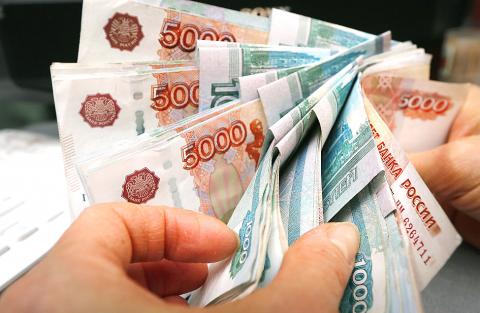Just when Russians thought it could not get any worse with the ruble tumbling as fast as the oil prices on which their economy depends, the people of St Petersburg are waking up to rationing.
However, in Russian President Vladimir Putin’s hometown, the martyr city that survived a nearly 900-day siege in which thousands starved to death in World War II, it is not food and drink that is being rationed, but metro tokens.
In one of the most bizarre episodes of panic buying in a nation notorious for its hoarding instincts in times of trouble, people have been buying up to 85,000 extra metro tokens a day so they can save three rubles (US$0.05) when the price goes up on Thursday.

Photo: Reuters
With more than 1.8 million sold so far this month the authorities had to step in and ban cashiers from selling people more than two tokens at a time. Signs of panic buying have emerged in recent weeks with many hard-pressed households hoarding sugar and buckwheat, one of the nation’s main staples, as the ruble at one point lost one-quarter of its value in just two days.
Worried about rising inflation and the real value of their wages and savings plummeting, poorer Russians have been stockpiling goods they think are likely to hold their value.
“I get the feeling people are investing in metro tokens,” said one passenger in front of the ticket desk at Prospekt Veteranov station.
Normally only about 15,000 metro tokens per day are sold in Russia’s second city, but as the ruble crisis worsened, that increased to between 80,000 and 100,000 per day.
The price of the tokens are set to rise from 28 rubles to 31 rubles on Thursday.
Russia’s monetary crisis — the worst in Putin’s 15 years in power — was sparked by the fall in the price of oil and worsened by Western sanctions over Ukraine. The ruble has lost about 40 percent of its value against the US dollar and the euro this year.
On Friday, Russian Minister of Finance Anton Siluanov said Russia’s economy could suffer a 4 percent contraction next year and see a budget deficit of 3 percent.
Siluanov told Russian reporters that the economy would contract 4 percent with oil prices at about US$60 a barrel, adding that he expected the ruble’s exchange rate to be about 51 rubles per US dollar.
“That’s the exchange rate which according to our estimates corresponds to the balance of payments,” he said.
He added that the government would have to further cut expenses or tap into reserves, noting that the planned 10 percent spending cut was not enough.
The central bank recently said the Russian contraction could be up to 4.8 percent at current oil prices, with a recovery not expected until 2017, but that was before it hiked interest rates by more than one-third to 17 percent, which is likely to also act as a drag on the economy.
On Friday, Russian authorities also significantly scaled up rescue funds for Trust Bank, saying they would provide up to US$2.4 billion in loans to bail out the medium-sized lender, the first bank to fall victim to the crisis.
The falling ruble has prompted panic buying of foreign currency in Russia and a spike in deposit withdrawals, heaping pressure on a vulnerable banking sector whose access to international capital markets has already been restricted by Western sanctions.
Siluanov said that authorities would provide additional capital to the nations’s second-largest bank, VTB, and fellow state lender Gazprombank.
VTB could receive 250 billion rubles (US$4.91 billion) and Gazprombank 70 billion rubles to help fund investment projects, including those planned by Russian Railways, Siluanov said.
It was not clear whether this support would be in addition to the 1 trillion ruble capital boost the banking sector is set to receive as part of legislation recently approved by parliament.
Credit agency Standard & Poor’s said this week it could downgrade Russia’s rating to junk as soon as January due to a rapid deterioration in “monetary flexibility” in the nation.
“Practically this [a downgrade] may mean the increase of capital outflow from Russia, which would be necessary to replace with instruments we have,” Russian Minister of Economic Development Alexei Ulyukayev said.
Russia might repurchase corporate bond issues, especially denominated in foreign currency, if needed, he added.
The nation’s gold and foreign exchange reserves have fallen to their lowest levels since 2009 as the central bank has spent billions to prop up the currency. Last week, reserves dropped by as much as US$15.7 billion to below US$400 billion, down from over US$510 billion at the start of the year.
Additional reporting by Reuters

US sports leagues rushed to get in on the multi-billion US dollar bonanza of legalized betting, but the arrest of an National Basketball Association (NBA) coach and player in two sprawling US federal investigations show the potential cost of partnering with the gambling industry. Portland Trail Blazers coach Chauncey Billups, a former Detroit Pistons star and an NBA Hall of Famer, was arrested for his alleged role in rigged illegal poker games that prosecutors say were tied to Mafia crime families. Miami Heat guard Terry Rozier was charged with manipulating his play for the benefit of bettors and former NBA player and

The DBS Foundation yesterday announced the launch of two flagship programs, “Silver Motion” and “Happier Caregiver, Healthier Seniors,” in partnership with CCILU Ltd, Hondao Senior Citizens’ Welfare Foundation and the Garden of Hope Foundation to help Taiwan face the challenges of a rapidly aging population. The foundation said it would invest S$4.91 million (US$3.8 million) over three years to foster inclusion and resilience in an aging society. “Aging may bring challenges, but it also brings opportunities. With many Asian markets rapidly becoming super-aged, the DBS Foundation is working with a regional ecosystem of like-minded partners across the private, public and people sectors

BREAKTHROUGH TECH: Powertech expects its fan-out PLP system to become mainstream, saying it can offer three-times greater production throughput Chip packaging service provider Powertech Technology Inc (力成科技) plans to more than double its capital expenditures next year to more than NT$40 billion (US$1.31 billion) as demand for its new panel-level packaging (PLP) technology, primarily used in chips for artificial intelligence (AI) applications, has greatly exceeded what it can supply. A significant portion of the budget, about US$1 billion, would be earmarked for fan-out PLP technology, Powertech told investors yesterday. Its heavy investment in fan-out PLP technology over the past 10 years is expected to bear fruit in 2027 after the technology enters volume production, it said, adding that the tech would

YEAR-END BOOST: The holiday shopping season in the US and Europe, combined with rising demand for AI applications, is expected to drive exports to a new high, the NDC said Taiwan’s business climate monitor improved last month, transitioning from steady growth for the first time in five months, as robust global demand for artificial intelligence (AI) products and new iPhone shipments boosted exports and corporate sales, the National Development Council (NDC) said yesterday. The council uses a five-color system to measure the nation’s economic state, with “green” indicating steady growth, “red” suggesting a boom and “blue” reflecting a recession. “Yellow-red” and “yellow-blue” suggest a transition to a stronger or weaker condition. The total score of the monitor’s composite index rose to 35 points from a revised 31 in August, ending a four-month